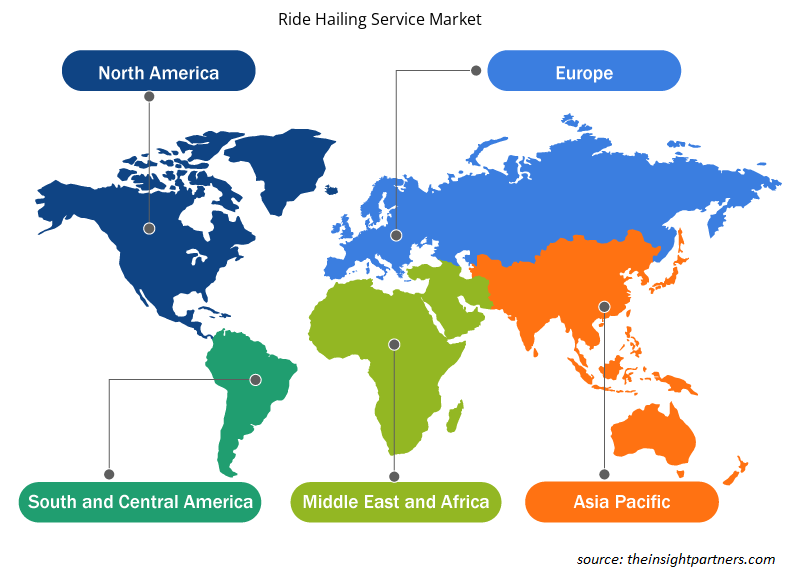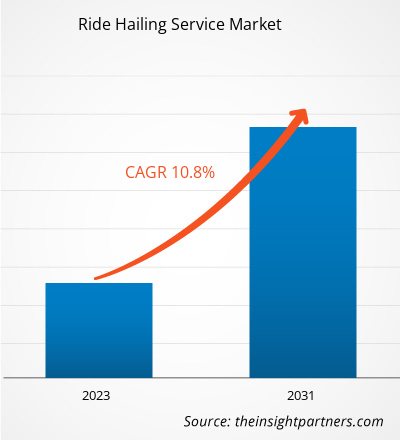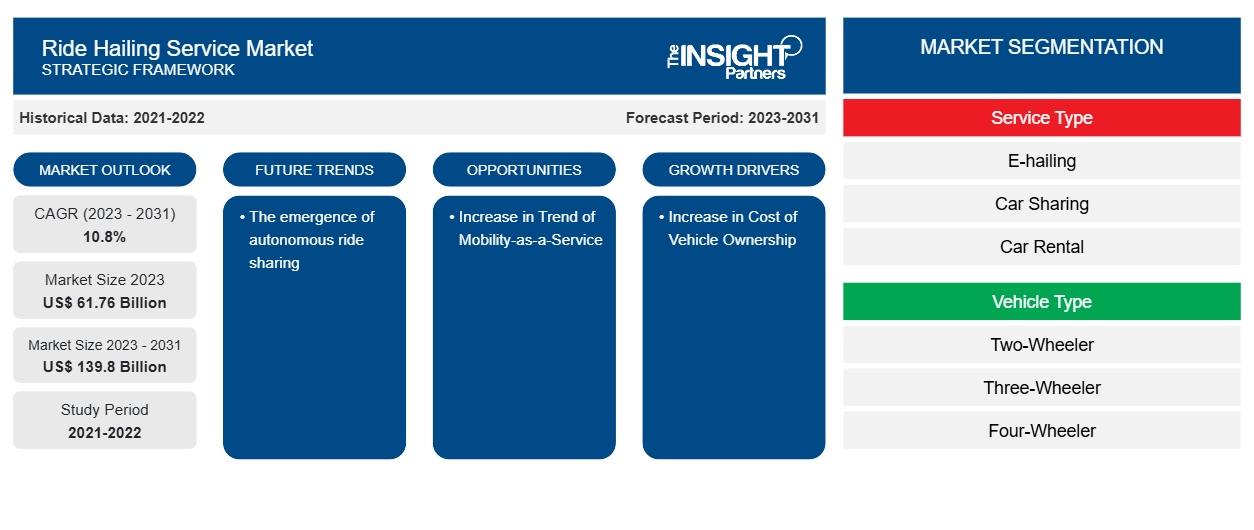配車サービス市場規模は、2023年の617.6億米ドルから2031年には1,398億米ドルに達すると予測されています。市場は2023年から2031年の間に10.8%のCAGRを記録すると予想されています。自動運転の配車サービスの出現は、今後も市場の重要なトレンドであり続けると思われます。
配車サービス市場分析
世界中でオンデマンド輸送サービスのトレンドが高まっており、今後数年間で市場の成長を牽引すると予想されています。さらに、予測期間中、車両所有コストの増加により、配車サービスの需要が高まると予想されています。さらに、世界中でモビリティ・アズ・ア・サービスのトレンドが高まり、2023年から2031年にかけて配車サービス市場の成長がさらに加速すると予想されています。
配車サービス市場の概要
配車サービス市場のエコシステムの主要な利害関係者には、テクノロジーソリューションプロバイダー、配車サービスプロバイダー、エンドユーザーが含まれます。テクノロジーソリューションプロバイダーには、コネクテッドデバイスやその他のハードウェアメーカー、ソフトウェア開発者が含まれます。テクノロジーソリューションプロバイダーの数の増加は、配車サービスのデジタル化を決定的に推進しています。オンデマンド輸送サービスのトレンドの高まり、雇用機会の創出、ミレニアル世代の自動車所有率の低さにより、配車サービスはCOVID後に増加すると予想されています。さらに、CO2排出量を削減するためのコネクテッドカーと自動運転車の技術的進歩と、配車サービスでの使用のためのこれらのスマートで効率的な車両の販売の大幅な増加が、世界市場の成長を促進しています。配車サービスプロバイダーは、テクノロジーソリューションプロバイダーからサービスを受けています。配車における技術開発の成長に伴い、配車サービス市場の需要が高まっています。
要件に合わせてレポートをカスタマイズする
このレポートの一部、国レベルの分析、Excelデータパックなど、あらゆるレポートを無料でカスタマイズできます。また、スタートアップや大学向けのお得なオファーや割引もご利用いただけます。
-
このレポートの主要な市場動向を入手してください。この無料サンプルには、市場動向から見積もりや予測に至るまでのデータ分析が含まれます。
配車サービス市場の推進要因と機会
自動車所有コストの増加が市場を有利に導く
ファイナンス、燃料、維持費、登録/税金、メンテナンス、減価償却はすべて、自動車の所有コストに影響します。自動車を所有するための費用は年々増加しています。アメリカ自動車協会(AAA)によると、減価償却は総所有コストの43%以上を占めています。ただし、メンテナンスやガソリンなどの他のコストは25%を占めています。燃料価格とメンテナンスコストの上昇は過去10年間で劇的に増加しており、今後数年間で増加すると予想されています。パンデミック中に自動車の所有が増加しましたが、2021年以降は減少し、パンデミック前のレベルに戻ると予想されています。これにより、配車サービスプロバイダーはこの人口動態の発展から利益を得ることができます。なぜなら、新しいテクノロジーに精通した世代はこれらのサービスの最もアクティブなユーザーの1つだからです。
モビリティ・アズ・ア・サービスのトレンド増加
車両を購入できない顧客は、モビリティサービスを通じてシームレスな移動を体験できます。モビリティ・アズ・ア・サービスは、カーシェアリングやライドヘイリングのコストを最大化することで、所有および運用コストを削減します。さらに、急速な都市化のペースはすでに交通渋滞につながっています。モビリティ・アズ・ア・サービス(MaaS)のコンセプトは、既存の公共および民間の交通ネットワークをより多く使用することで交通渋滞を最小限に抑えるためのより良い選択肢かもしれません。スマートシティの交通を処理するための効果的なソリューションに対する緊急かつ増大する需要は、2031年までライドヘイリングサービス市場の成長を促進すると予想されます。したがって、モビリティ・アズ・ア・サービス(MaaS)の増加傾向は、世界のライドヘイリングサービス市場の成長を促進すると予想されます。
配車サービス市場レポートのセグメンテーション分析
配車サービス市場分析の導出に貢献した主なセグメントは、サービスタイプ、車両タイプ、場所、エンドユーザーです。
- サービスタイプに基づいて、配車サービス市場は、E-hailing、カーシェアリング、レンタカー、ステーションベースのモビリティに分かれています。E-hailingセグメントは、2023年に最大の市場シェアを占めました。
- 車両タイプ別に見ると、市場は二輪車、三輪車、四輪車、その他に分類されています。四輪車セグメントは2023年に市場で最大のシェアを占めました。
- 場所に基づいて、市場は都市部と農村部に分かれています。都市部は2023年に市場の大きなシェアを占めました。
- エンドユーザー別に見ると、市場は機関投資家向けと個人投資家向けに分類されます。2023年には機関投資家向けセグメントが市場で大きなシェアを占めました。
地域別配車サービス市場シェア分析
配車サービス市場レポートの地理的範囲は、主に北米、アジア太平洋、ヨーロッパ、中東およびアフリカ、南米の 5 つの地域に分かれています。
配車サービス市場レポートの対象範囲は、北米(米国、カナダ、メキシコ)、欧州(ドイツ、フランス、イタリア、スペイン、英国、その他の欧州)、アジア太平洋(中国、インド、オーストラリア、日本、韓国、その他のアジア太平洋)、中東およびアフリカ(南アフリカ、サウジアラビア、UAE、その他の中東およびアフリカ)、南米(ブラジル、アルゼンチン、その他の南米)です。収益の面では、2023年の配車サービス市場シェアはアジア太平洋が独占しました。北米は世界の配車サービス市場への収益貢献度で2番目に大きく、ヨーロッパがそれに続きました。
配車サービス市場の地域別分析
予測期間を通じて配車サービス市場に影響を与える地域的な傾向と要因は、Insight Partners のアナリストによって徹底的に説明されています。このセクションでは、北米、ヨーロッパ、アジア太平洋、中東、アフリカ、南米、中米にわたる配車サービス市場のセグメントと地理についても説明します。

- 配車サービス市場の地域別データを入手
配車サービス市場レポートの範囲
| レポート属性 | 詳細 |
|---|---|
| 2023年の市場規模 | 617.6億米ドル |
| 2031年までの市場規模 | 1,398億米ドル |
| 世界のCAGR(2023年~2031年) | 10.8% |
| 履歴データ | 2021-2022 |
| 予測期間 | 2023-2031 |
| 対象セグメント |
サービスタイプ別
|
| 対象地域と国 |
北米
|
| 市場リーダーと主要企業プロフィール |
|
配車サービス市場のプレーヤー密度:ビジネスダイナミクスへの影響を理解する
ライドヘイリングサービス市場は、消費者の嗜好の変化、技術の進歩、製品の利点に対する認識の高まりなどの要因により、エンドユーザーの需要が高まり、急速に成長しています。需要が高まるにつれて、企業は提供内容を拡大し、消費者のニーズを満たすために革新し、新たなトレンドを活用し、市場の成長をさらに促進しています。
市場プレーヤー密度とは、特定の市場または業界内で活動している企業または会社の分布を指します。これは、特定の市場スペースに、その規模または総市場価値と比較して、どれだけの競合相手 (市場プレーヤー) が存在するかを示します。
配車サービス市場で事業を展開している主要企業は次のとおりです。
- ANIテクノロジーズ株式会社
- ダイムラーAG
- デルファイ・テクノロジーズ
- DiDiグローバル株式会社
- ゲット
- グラブホールディングス株式会社
免責事項:上記の企業は、特定の順序でランク付けされていません。

- 配車サービス市場のトップキープレーヤーの概要を入手
配車サービス市場のニュースと最近の動向
配車サービス市場は、主要な企業出版物、協会データ、データベースなどの一次調査と二次調査を経て定性的および定量的データを収集することで評価されます。配車サービス市場の動向のいくつかを以下に示します。
- 配車サービスプロバイダーのカカオモビリティは、アジアと中東で配車サービスを開始し、存在感を拡大しました。(出典:カカオモビリティ、プレスリリース、2023年11月)
- DiDi Global Inc.は、南アフリカのケープタウンでドライバーの登録手続きを開始し、同国第2の都市の消費者に配車サービスを提供し始めた。(出典:DiDi Global Inc.、プレスリリース、2021年3月)
配車サービス市場レポートの対象範囲と成果物
「ライドヘイリングサービス市場規模と予測(2021〜2031年)」レポートでは、以下の分野をカバーする市場の詳細な分析を提供しています。
- 調査対象範囲に含まれるすべての主要市場セグメントについて、世界、地域、国レベルでの配車サービス市場規模と予測
- 配車サービス市場の動向、およびドライバー、制約、主要な機会などの市場動向
- 詳細なPESTおよびSWOT分析
- 主要な市場動向、世界および地域の枠組み、主要プレーヤー、規制、最近の市場動向を網羅した配車サービス市場分析
- 配車サービス市場の市場集中、ヒートマップ分析、主要プレーヤー、最近の動向を網羅した業界の状況と競争分析
- 詳細な企業プロフィール
- 過去2年間の分析、基準年、CAGRによる予測(7年間)
- PEST分析とSWOT分析
- 市場規模価値/数量 - 世界、地域、国
- 業界と競争環境
- Excel データセット
最新レポート
お客様の声
購入理由
- 情報に基づいた意思決定
- 市場動向の理解
- 競合分析
- 顧客インサイト
- 市場予測
- リスク軽減
- 戦略計画
- 投資の正当性
- 新興市場の特定
- マーケティング戦略の強化
- 業務効率の向上
- 規制動向への対応























 無料サンプルを入手 - 配車サービス市場
無料サンプルを入手 - 配車サービス市場